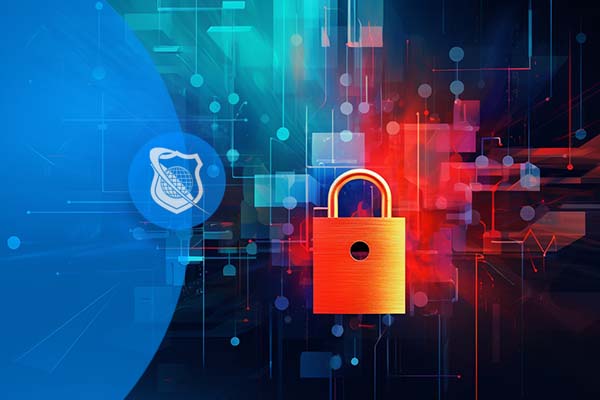In the digital era, the surge in cyber threats like data breaches and cyberattacks has placed network security at the forefront of IT priorities. As we navigate this landscape, it’s crucial to comprehend the essence of network security, its significance, and the measures we can adopt to fortify our digital fortresses.
Defining Network Security: A Cornerstone of Cyber Resilience
Network security, a crucial segment of the broader cybersecurity domain, is the art and science of safeguarding computer networks and their interconnected devices from unauthorized access and potential threats. It’s not merely about safeguarding the physical hardware; it involves a comprehensive strategy encompassing both physical and digital defenses. Given the sophistication and frequency of contemporary cyber threats, the role of network security is more pivotal than ever.
Why Prioritize Network Security?
The imperative of network security is underscored by its role in preserving data integrity and confidentiality within organizations. As we increasingly digitize our sensitive information, the onus is on robust network security measures to shield this data from unauthorized access. The statistics are telling: by 2020, our digital universe is poised to hold over 2,314 exabytes of data. Protecting this vast data pool is not just a logistical challenge but a critical security mandate.
Network Administrator Career Path
This comprehensive training series is designed to provide both new and experienced network administrators with a robust skillset enabling you to manager current and networks of the future.
Navigating the Maze of Network Vulnerabilities
To fortify networks effectively, understanding the landscape of potential vulnerabilities is paramount. These vulnerabilities can range from outdated firmware and improperly installed hardware to insecure passwords and inherent design flaws in network architecture. Awareness and proactive management of these vulnerabilities are foundational to robust network security.
Navigating the labyrinth of network vulnerabilities is crucial for maintaining robust network security. Here are the most common vulnerabilities that IT professionals and network administrators need to be aware of:
- Improperly Installed Hardware or Software: Incorrect installation can leave systems exposed to attacks. This includes improperly configured network devices, servers, and applications.
- Outdated Operating Systems or Firmware: Failing to update systems and firmware can leave known vulnerabilities unpatched, making it easier for attackers to exploit these weaknesses.
- Misused Hardware or Software: Misconfiguration or inappropriate use of network resources can inadvertently expose networks to risks.
- Lack of Physical Security: Insufficient security measures to protect hardware can lead to unauthorized physical access to network devices and servers.
- Insecure Password Practices: Weak, default, or reused passwords can be easily guessed or cracked, giving attackers easy access to network resources.
- Design Flaws in Operating Systems or Networks: Inherent vulnerabilities within the architecture of operating systems or network designs can be exploited unless identified and mitigated.
Identifying and addressing these vulnerabilities are essential steps in strengthening network security and protecting against potential threats.
Physical and Cybersecurity: Two Sides of the Same Coin
While cybersecurity often grabs the headlines, the physical security of network infrastructure is equally non-negotiable. Ensuring the physical safety of servers and network devices, coupled with stringent access control and surveillance measures, forms the bedrock of a comprehensive network security strategy.
Physical security and cybersecurity are integral components of an overall security strategy, each addressing different aspects of protection but equally vital. Here’s a discussion on the physical issues and considerations in ensuring comprehensive security:
- Secure Location for Hardware: Network servers, data centers, and related hardware should be housed in secure, restricted-access locations. This includes protection against natural disasters, theft, and unauthorized physical access.
- Access Control: Implementing robust access control systems ensures that only authorized personnel can enter sensitive areas. This may include key cards, biometric scanners, or security personnel.
- Surveillance Systems: CCTV cameras and other surveillance systems help monitor sensitive areas, deterring unauthorized access and recording evidence of any security breaches.
- Environmental Controls: Protecting hardware from environmental hazards is crucial. This includes maintaining appropriate temperature and humidity levels in server rooms and protecting against water damage, fire, or other environmental risks.
- Physical Intrusion Detection: Systems to detect unauthorized entry, such as motion sensors or door alarms, can alert security personnel to potential breaches.
- Device Security: Ensuring that individual devices like laptops, mobile phones, and tablets are physically secure and can be remotely wiped or locked if they fall into the wrong hands.
Physical security measures, when integrated with robust cybersecurity practices, create a comprehensive defense against a wide array of threats, safeguarding an organization’s assets, data, and personnel.
Information Security Manager Career Path
Propel your career forward and be part of an essential member of any management team as an Information Security Manager. This advanced training series is designed specifically for those want to move up into a management position in the IT field.
The Spectrum of Network Security Attacks
The landscape of network security threats is both diverse and dynamic. From data theft and insider threats to sophisticated malware and social engineering attacks, the threat matrix is complex and evolving. Staying vigilant and responsive to these threats is not optional but a core requirement for IT professionals.
Here are some of the most prevalent types of network security attacks that organizations need to be vigilant about:
- Data Theft (Data Exfiltration): Unauthorized access and extraction of sensitive data from a network. Attackers might use stolen credentials or exploit vulnerabilities to access and siphon off confidential information.
- Insider Threats: Security breaches initiated by individuals within the organization. This could be due to malicious intent, negligence, or inadvertent errors, leading to unauthorized access or data leakage.
- Malware Attacks: Involves malicious software such as viruses, worms, trojans, and ransomware infiltrating and damaging the network, often leading to data theft, data corruption, or service disruption.
- Password Attacks: Attempts to gain unauthorized access to systems by cracking or guessing passwords. Techniques may include brute force attacks, dictionary attacks, or exploiting weak or default passwords.
- Social Engineering: Manipulating individuals into divulging confidential information or breaking normal security procedures. Examples include phishing, baiting, pretexting, and spear-phishing.
- Denial of Service (DoS) and Distributed Denial of Service (DDoS) Attacks: Overwhelming a network’s resources by flooding it with excessive requests, rendering it unable to provide services to legitimate users.
- Man-in-the-Middle (MitM) Attacks: Intercepting and possibly altering the communication between two parties without their knowledge.
- SQL Injection: Exploiting vulnerabilities in a database-driven application to execute malicious SQL commands, potentially giving attackers access to sensitive data.
- Cross-Site Scripting (XSS): Injecting malicious scripts into web pages viewed by other users, potentially stealing data such as session tokens or login credentials.
- Zero-day Exploits: Attacks that occur on the same day a vulnerability is discovered, before a patch or solution is implemented.
Staying informed about these types of attacks and implementing a robust security strategy can help organizations protect their networks from potential threats.
Information Security Analyst Career Path
An Information Security Analyst plays a pivotal role in safeguarding an organization’s digital infrastructure and sensitive data. This job involves a blend of technical expertise, vigilance, and continuous learning to protect against ever-evolving cyber threats.
A Kaleidoscope of Network Security Solutions
Addressing the multifaceted nature of network threats demands a multifaceted defense strategy. Solutions range from antivirus software and encryption to firewalls, multi-factor authentication, and network segmentation. Each of these solutions plays a distinct role in a cohesive network security strategy, designed to address specific vulnerabilities and threats.
The landscape of network security is intricate and multi-faceted, requiring a diverse array of solutions to safeguard against a broad spectrum of threats. Here are key components of a comprehensive network security strategy:
- Antivirus and Anti-malware Software: Software solutions designed to detect, prevent, and remove malicious software such as viruses, worms, and ransomware.
- Firewalls: Hardware or software-based network security systems that monitor and control incoming and outgoing network traffic based on predetermined security rules.
- Encryption: The process of encoding data to prevent unauthorized access. Encryption is essential for protecting sensitive data, especially when transmitted over unsecured networks like the internet.
- Multi-factor Authentication (MFA): A security system that requires more than one method of authentication from independent categories of credentials to verify the user’s identity for a login or other transaction.
- Security Information and Event Management (SIEM): Provides real-time analysis of security alerts generated by applications and network hardware. It’s used for log management, event correlation, and incident response.
- Intrusion Prevention Systems (IPS): Network security appliances that monitor network and/or system activities for malicious activity, log information about such activities, report it, and optionally attempt to block or stop it.
- Data Loss Prevention (DLP): Tools and processes to ensure that sensitive data is not lost, misused, or accessed by unauthorized users.
- Network Segmentation: Dividing a computer network into subnetworks, each being a network segment or subnet, to enhance performance and security.
- Virtual Private Networks (VPN): Encrypts internet traffic and disguises online identity, making it more difficult for third parties to track activities and intercept data.
- Patch Management: The process of distributing and applying updates to software. These patches are often necessary to correct security vulnerabilities and other bugs.
- Endpoint Security: Security approaches that focus on locking down endpoints—individual devices like mobile phones, tablets, and laptops—to keep networks secure.
- Web Security: Tools and measures to protect web users and their interactions with websites and online services, typically against malware infections and data breaches.
- Email Security: Protects email accounts, content, and communication against unauthorized access, loss, or compromise.
This kaleidoscope of network security solutions, when integrated and managed effectively, can provide a robust defense against the myriad threats that modern networks face.
Best Practices and Proactive Measures in Network Security
The journey to robust network security is marked by continuous vigilance and proactive measures. This includes stringent access controls, adherence to password best practices, and regular security audits and testing. Moreover, preparing for the worst-case scenario with a comprehensive data recovery plan ensures resilience in the face of potential breaches.
Maintaining robust network security requires a blend of best practices and proactive measures to anticipate and mitigate potential threats. Here are key strategies and actions that can significantly enhance network security:
- Regular Software Updates and Patching: Consistently update and patch operating systems, applications, and firmware on all devices to close security gaps.
- Use Strong, Unique Passwords: Enforce policies that require complex passwords and change them regularly. Avoid using the same password across multiple accounts.
- Implement Multi-Factor Authentication (MFA): Add an extra layer of security by requiring two or more verification methods to gain access to your network and sensitive data.
- Conduct Regular Security Audits and Assessments: Regularly evaluate your network for vulnerabilities. This should include penetration testing and security assessments.
- Educate and Train Employees: Regularly train staff on security protocols, potential threats like phishing or social engineering, and how to respond to suspicious activity.
- Backup Data Regularly: Ensure that all critical data is backed up in a secure and remote location, and test the restoration process regularly.
- Monitor Network Traffic: Keep an eye on network traffic to detect unusual patterns that could indicate a breach or malware infection.
- Limit User Access and Privileges: Operate on the principle of least privilege, ensuring users have only the access that is strictly necessary for their work.
- Secure Wi-Fi Networks: Ensure that Wi-Fi networks are secure, hidden, and encrypted. Use the latest encryption standards and regularly change Wi-Fi passwords.
- Use Secure and Encrypted Communication Channels: Utilize VPNs and encrypted messaging services for secure communication.
- Deploy Firewalls and Antivirus Solutions: Use these tools to create a barrier between your data and cybercriminals, and ensure they are always updated.
- Regularly Update Security Policies: Keep your security policies up-to-date and ensure they are thorough and cover all aspects of your organization’s operations.
- Physical Security Measures: Ensure physical access to your network and devices is secure. This includes using security cameras, locks, biometric scanners, and secure areas for sensitive equipment.
- Incident Response Planning: Have a clear, tested plan in place for responding to security incidents. This should include steps to contain the breach, assess the damage, and communicate with stakeholders.
- Secure Endpoints: Ensure that all devices connecting to the network are secure. This includes employee personal devices if they are used for work (BYOD policies).
By consistently implementing these best practices and proactive measures, organizations can significantly fortify their network security posture against a wide array of potential threats.
Choose Your IT Career Path
ITU provides you with a select grouping of courses desgined specfically to guide you on your career path. To help you best succeed, these specialized career path training series offer you all the essentials needed to begin or excel in your choosen IT career.
The Road Ahead: Continuous Learning and Adaptation
The realm of network security is characterized by constant evolution. Staying ahead of the curve demands ongoing education and adaptability from IT professionals. Certifications like CompTIA Network+ and continuous professional development are pivotal in navigating this ever-changing landscape.
Tools and Technologies: The Arsenal for Network Troubleshooting
Complementing the human element, a suite of diagnostic and troubleshooting tools—from packet sniffers and port scanners to hardware tools like cable testers and multimeters—equip IT professionals to diagnose and resolve network issues effectively.
For effective network troubleshooting, a range of tools and technologies are indispensable. Here are some key recommendations that can help IT professionals diagnose and resolve network issues:
- Packet Sniffers (Network Analyzers): Tools like Wireshark that capture and analyze packets traveling through the network, helping in identifying network problems, bottlenecks, and unauthorized activity.
- Port Scanners: Utilities like Nmap that scan network devices for open ports. They provide insights into the services running on each port and potential vulnerabilities.
- Protocol Analyzers: These tools help in dissecting network protocols and diagnosing protocol errors. They are essential for troubleshooting complex network communication issues.
- Wi-Fi Analyzers: Applications that assess the performance of wireless networks, identifying signal strengths, interference issues, and optimal placement for access points.
- Bandwidth Monitoring and Analysis Tools: Solutions like SolarWinds or PRTG Network Monitor that track bandwidth usage across the network, helping identify bottlenecks or unexpected spikes in traffic.
- Network Mapping Tools: Tools like SolarWinds Network Topology Mapper automatically discover and map network devices, aiding in visualizing network structure and identifying problem areas.
- Configuration Management Tools: Systems that manage network device configurations, ensuring that changes are properly documented and can be rolled back if they cause issues.
- Network Simulators: Tools like GNS3 or Cisco Packet Tracer that simulate network environments. They are invaluable for testing network configurations and changes before deploying them in a live environment.
- Syslog Servers and SIEM Tools: Systems that collect and analyze logs and security events from various network devices, providing insights into security incidents and operational issues.
- DNS Troubleshooting Tools: Utilities like nslookup or dig that help diagnose DNS-related issues, ensuring that domain names are properly resolved to IP addresses.
- IP Address Management Tools: Systems for tracking and managing IP addresses within the network, preventing conflicts and ensuring efficient allocation of IP resources.
- Remote Monitoring and Management (RMM): Tools that enable remote monitoring and management of network devices, allowing for proactive issue detection and resolution.
- Hardware Tools: Including cable testers, network testers, punch-down tools, and TDRs (Time-Domain Reflectometers) for diagnosing and repairing physical infrastructure issues.
- Virtual Network Tools: Solutions for creating and managing virtual networks, essential for isolating and troubleshooting issues in complex network environments.
Integrating these tools into your network management and troubleshooting practices can provide a comprehensive view of network performance, pinpoint issues with precision, and facilitate prompt resolution, ensuring network reliability and efficiency.
In summary, network security is not a static goal but a dynamic process. It demands a holistic approach, combining physical and digital defenses, continuous learning, and the right mix of tools and technologies. In this digital age, where data is akin to currency, investing in robust network security is not just prudent; it’s imperative.
Lock In Our Lowest Price Ever For Only $16.99 Monthly Access
Your career in information technology last for years. Technology changes rapidly. An ITU Online IT Training subscription offers you flexible and affordable IT training. With our IT training at your fingertips, your career opportunities are never ending as you grow your skills.
Plus, start today and get 30 days for only $1.00 with no obligation. Cancel anytime.
Frequently Asked Questions Related To Network Security
What is Network Security and Why is it Important?
Network security refers to the policies, practices, and tools designed to protect data integrity, confidentiality, and accessibility within a network infrastructure. It’s crucial because it helps protect sensitive data from unauthorized access, misuse, or theft. In today’s digital age, where cyber threats are increasingly sophisticated, robust network security is fundamental to maintaining the trust of customers and safeguarding an organization’s reputation and assets.
How Does a Firewall Contribute to Network Security?
A firewall acts as a barrier between your internal network and incoming traffic from external sources (such as the internet), filtering the traffic based on a defined set of security rules. It helps prevent malicious software and attackers from accessing your network and sensitive data. Firewalls can be hardware, software, or a combination of both, and are essential in blocking unauthorized access while permitting legitimate communications to pass.
What Are the Most Common Network Security Threats?
The most prevalent threats include malware (such as viruses, worms, and ransomware), phishing attacks, man-in-the-middle attacks, denial-of-service attacks, and SQL injection attacks. Additionally, insider threats, either intentional or due to negligence, pose significant risks. Staying informed about these threats and adopting proactive security measures is vital for maintaining network integrity.
How Can Organizations Strengthen Their Network Security?
Organizations can enhance their network security by implementing strong password policies, using multi-factor authentication, regularly updating and patching systems, encrypting sensitive data, and training employees on security best practices. Additionally, conducting regular security assessments and audits, deploying advanced security solutions like firewalls and intrusion detection systems, and developing a comprehensive incident response plan are crucial steps.
What Role Do Employees Play in Network Security?
Employees are often considered the first line of defense in network security. They can either be a security asset or a potential vulnerability, depending on their awareness and actions. Educating employees about safe internet practices, the importance of strong passwords, recognizing phishing attempts, and the proper handling of sensitive data can significantly reduce the risk of security breaches. Encouraging a culture of security mindfulness and ensuring clear communication about policies and procedures are also key factors in fortifying an organization’s security posture.















